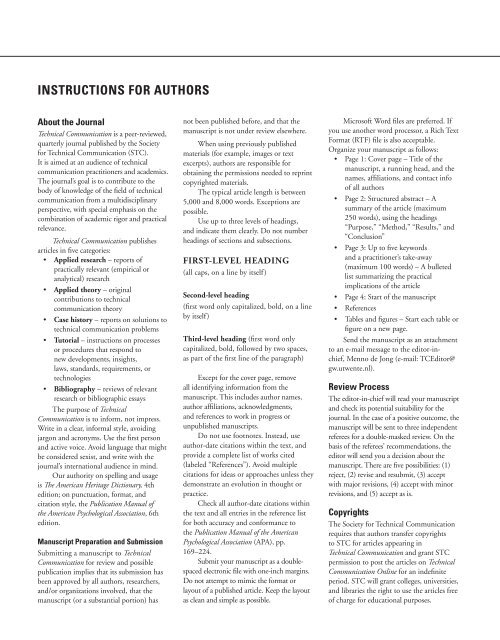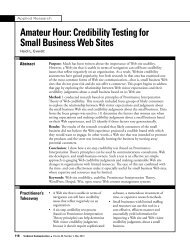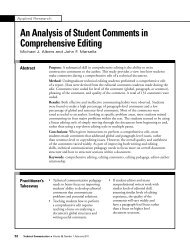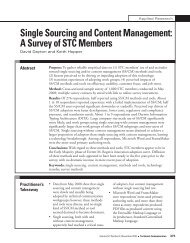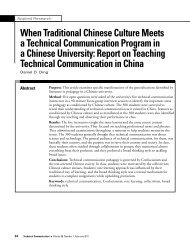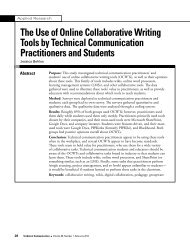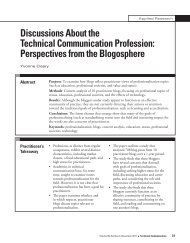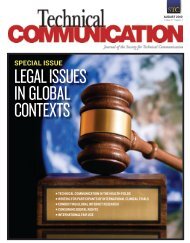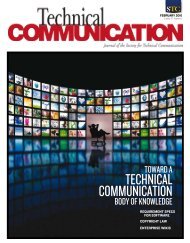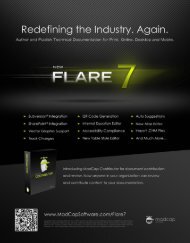SPECIAL ISSUE
Download: November 2011 - Technical Communication - Society for ...
Download: November 2011 - Technical Communication - Society for ...
- No tags were found...
Create successful ePaper yourself
Turn your PDF publications into a flip-book with our unique Google optimized e-Paper software.
INSTRUCTIONS FOR AUTHORSAbout the JournalTechnical Communication is a peer-reviewed,quarterly journal published by the Societyfor Technical Communication (STC).It is aimed at an audience of technicalcommunication practitioners and academics.The journal’s goal is to contribute to thebody of knowledge of the field of technicalcommunication from a multidisciplinaryperspective, with special emphasis on thecombination of academic rigor and practicalrelevance.Technical Communication publishesarticles in five categories:• Applied research – reports ofpractically relevant (empirical oranalytical) research• Applied theory – originalcontributions to technicalcommunication theory• Case history – reports on solutions totechnical communication problems• Tutorial – instructions on processesor procedures that respond tonew developments, insights,laws, standards, requirements, ortechnologies• Bibliography – reviews of relevantresearch or bibliographic essaysThe purpose of TechnicalCommunication is to inform, not impress.Write in a clear, informal style, avoidingjargon and acronyms. Use the first personand active voice. Avoid language that mightbe considered sexist, and write with thejournal’s international audience in mind.Our authority on spelling and usageis The American Heritage Dictionary, 4thedition; on punctuation, format, andcitation style, the Publication Manual ofthe American Psychological Association, 6thedition.Manuscript Preparation and SubmissionSubmitting a manuscript to TechnicalCommunication for review and possiblepublication implies that its submission hasbeen approved by all authors, researchers,and/or organizations involved, that themanuscript (or a substantial portion) hasnot been published before, and that themanuscript is not under review elsewhere.When using previously publishedmaterials (for example, images or textexcerpts), authors are responsible forobtaining the permissions needed to reprintcopyrighted materials.The typical article length is between5,000 and 8,000 words. Exceptions arepossible.Use up to three levels of headings,and indicate them clearly. Do not numberheadings of sections and subsections.FIRST-LEVEL HEADING(all caps, on a line by itself)Second-level heading(first word only capitalized, bold, on a lineby itself)Third-level heading (first word onlycapitalized, bold, followed by two spaces,as part of the first line of the paragraph)Except for the cover page, removeall identifying information from themanuscript. This includes author names,author affiliations, acknowledgments,and references to work in progress orunpublished manuscripts.Do not use footnotes. Instead, useauthor-date citations within the text, andprovide a complete list of works cited(labeled “References”). Avoid multiplecitations for ideas or approaches unless theydemonstrate an evolution in thought orpractice.Check all author-date citations withinthe text and all entries in the reference listfor both accuracy and conformance tothe Publication Manual of the AmericanPsychological Association (APA), pp.169–224.Submit your manuscript as a doublespacedelectronic file with one-inch margins.Do not attempt to mimic the format orlayout of a published article. Keep the layoutas clean and simple as possible.Microsoft Word files are preferred. Ifyou use another word processor, a Rich TextFormat (RTF) file is also acceptable.Organize your manuscript as follows:• Page 1: Cover page – Title of themanuscript, a running head, and thenames, affiliations, and contact infoof all authors• Page 2: Structured abstract – Asummary of the article (maximum250 words), using the headings“Purpose,” “Method,” “Results,” and“Conclusion”• Page 3: Up to five keywordsand a practitioner’s take-away(maximum 100 words) – A bulletedlist summarizing the practicalimplications of the article• Page 4: Start of the manuscript• References• Tables and figures – Start each table orfigure on a new page.Send the manuscript as an attachmentto an e-mail message to the editor-inchief,Menno de Jong (e-mail: TCEditor@gw.utwente.nl).Review ProcessThe editor-in-chief will read your manuscriptand check its potential suitability for thejournal. In the case of a positive outcome, themanuscript will be sent to three independentreferees for a double-masked review. On thebasis of the referees’ recommendations, theeditor will send you a decision about themanuscript. There are five possibilities: (1)reject, (2) revise and resubmit, (3) acceptwith major revisions, (4) accept with minorrevisions, and (5) accept as is.CopyrightsThe Society for Technical Communicationrequires that authors transfer copyrightsto STC for articles appearing inTechnical Communication and grant STCpermission to post the articles on TechnicalCommunication Online for an indefiniteperiod. STC will grant colleges, universities,and libraries the right to use the articles freeof charge for educational purposes.


